The multivesicular body-localized GTPase ARFA1b/1c is important for callose deposition and ROR2 syntaxin-dependent preinvasive basal defense in barley
- PMID: 21057060
- PMCID: PMC3015129
- DOI: 10.1105/tpc.110.078063
The multivesicular body-localized GTPase ARFA1b/1c is important for callose deposition and ROR2 syntaxin-dependent preinvasive basal defense in barley
Abstract
Host cell vesicle traffic is essential for the interplay between plants and microbes. ADP-ribosylation factor (ARF) GTPases are required for vesicle budding, and we studied the role of these enzymes to identify important vesicle transport pathways in the plant-powdery mildew interaction. A combination of transient-induced gene silencing and transient expression of inactive forms of ARF GTPases provided evidence that barley (Hordeum vulgare) ARFA1b/1c function is important for preinvasive penetration resistance against powdery mildew, manifested by formation of a cell wall apposition, named a papilla. Mutant studies indicated that the plasma membrane-localized REQUIRED FOR MLO-SPECIFIED RESISTANCE2 (ROR2) syntaxin, also important for penetration resistance, and ARFA1b/1c function in the same vesicle transport pathway. This was substantiated by a requirement of ARFA1b/1c for ROR2 accumulation in the papilla. ARFA1b/1c is localized to multivesicular bodies, providing a functional link between ROR2 and these organelles in penetration resistance. During Blumeria graminis f sp hordei penetration attempts, ARFA1b/1c-positive multivesicular bodies assemble near the penetration site hours prior to the earliest detection of callose in papillae. Moreover, we showed that ARFA1b/1c is required for callose deposition in papillae and that the papilla structure is established independently of ARFA1b/1c. This raises the possibility that callose is loaded into papillae via multivesicular bodies, rather than being synthesized directly into this cell wall apposition.
Figures
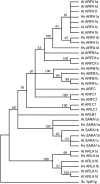
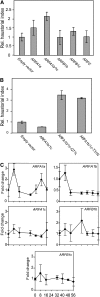

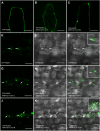
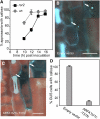

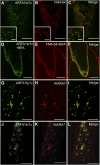
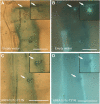
Comment in
-
Linking multivesicular bodies to resistance against fungal invasion.Plant Cell. 2010 Nov;22(11):3505. doi: 10.1105/tpc.110.221110. Epub 2010 Nov 9. Plant Cell. 2010. PMID: 21062892 Free PMC article. No abstract available.
-
ARF1 localizes to the golgi and the trans-golgi network.Plant Cell. 2011 Mar;23(3):846-9; author reply 849-50. doi: 10.1105/tpc.110.082099. Epub 2011 Mar 15. Plant Cell. 2011. PMID: 21406621 Free PMC article. No abstract available.
References
-
- An Q., Ehlers K., Kogel K.H., van Bel A.J., Hückelhoven R. (2006a). Multivesicular compartments proliferate in susceptible and resistant MLA12-barley leaves in response to infection by the biotrophic powdery mildew fungus. New Phytol. 172: 563–576 - PubMed
-
- An Q.L., Hückelhoven R., Kogel K.H., van Bel A.J.E. (2006b). Multivesicular bodies participate in a cell wall-associated defence response in barley leaves attacked by the pathogenic powdery mildew fungus. Cell. Microbiol. 8: 1009–1019 - PubMed
-
- Assaad F.F., Qiu J.L., Youngs H., Ehrhardt D., Zimmerli L., Kalde M., Wanner G., Peck S.C., Edwards H., Ramonell K., Somerville C.R., Thordal-Christensen H. (2004). The PEN1 syntaxin defines a novel cellular compartment upon fungal attack and is required for the timely assembly of papillae. Mol. Biol. Cell 15: 5118–5129 - PMC - PubMed
-
- Bednarek P., Pislewska-Bednarek M., Svatos A., Schneider B., Doubsky J., Mansurova M., Humphry M., Consonni C., Panstruga R., Sanchez-Vallet A., Molina A., Schulze-Lefert P. (2009). A glucosinolate metabolism pathway in living plant cells mediates broad-spectrum antifungal defense. Science 323: 101–106 - PubMed
Publication types
MeSH terms
Substances
LinkOut - more resources
Full Text Sources
Miscellaneous

